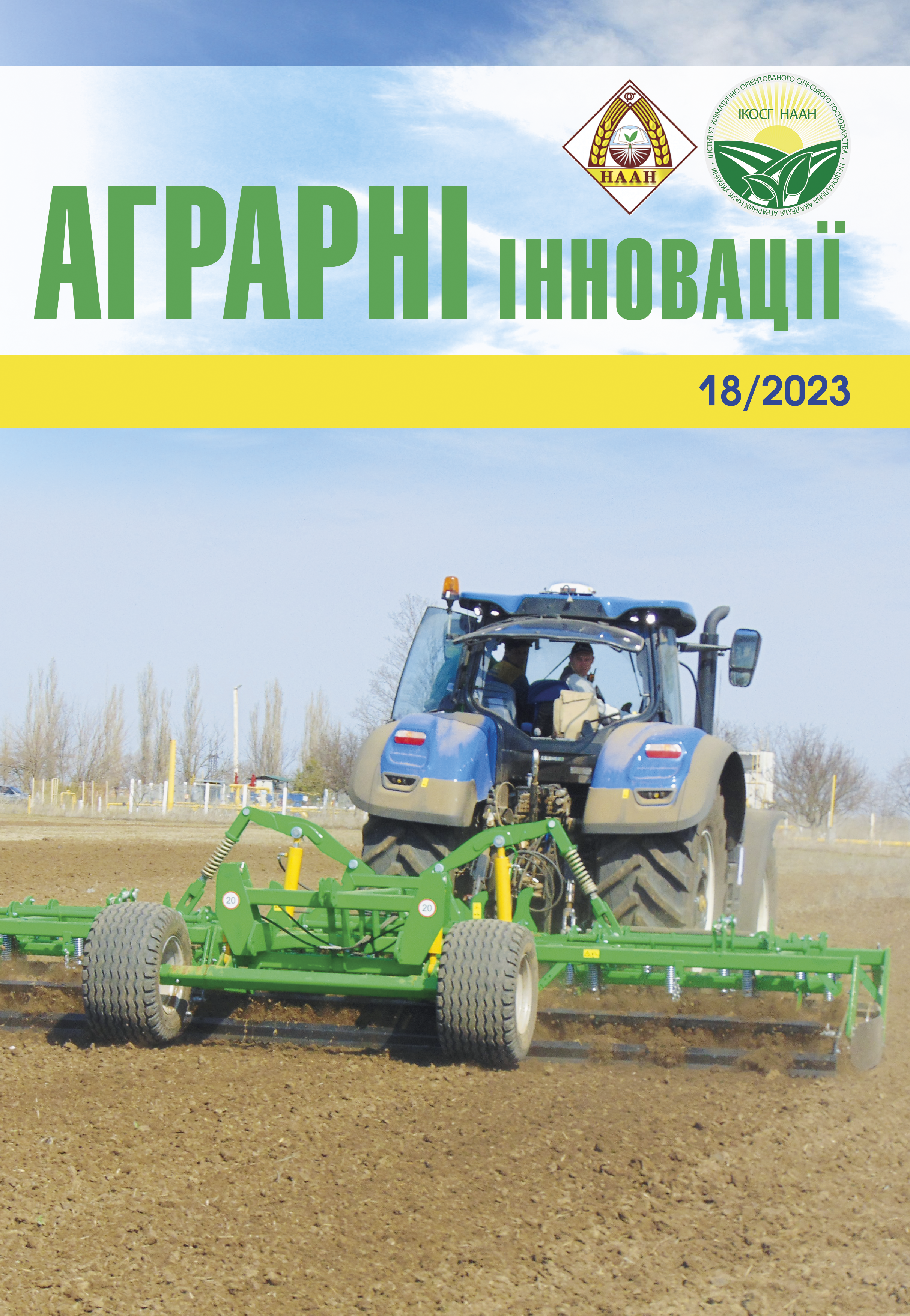AGRIBIOLOGICAL CHARACTERIZATION OF NEW GENETIC SOURCES OF HIGH PROTEIN CONTENT OF GRAIN AND THEIR PECULIARITIES IN NITROGEN ACCUMULATION AND REUTILIZATION
Abstract
Objective. To investigate and characterize by a complex of traits and identify genetic sources of high protein content and to study the peculiarities of nitrogen accumulation in different organs of the vegetative part of plants and its reutilization into grain during the spring-summer vegetation in experimental lines in comparison with other genotypes. Methods. The experiment was carried out on the experimental fields of the SGA NSCNS after the restoration of spring vegetation in 2020–2022. Research methods: field, laboratory, statistical. Results. Experimental lines from backcross hybridization with genes of high protein content from Triticum. Dicoccoides (GPC-B1) line with Aegilops tauschii were studied for a complex of traits. As a result, the agrobiological characteristics of the experimental lines were given in comparison with the standard varieties: Kuyalnik, Odeska 16, Shchedritsa, and Kolonia. Based on the data obtained, the percentage of nitrogen recycling from the stage of tube emergence to waxy ripeness of grain for stem and leaves was calculated. It has been shown that in winter wheat plants of new varieties (Kolonia, Kuyalnyk, Shchedrish) the efficiency of nitrogen recycling from the vegetative parts of the shoot to the grain is higher than in Odessanska 16. However, high-intensity varieties forming a significantly higher yield are inferior to Odeska 16 in terms of protein content. Experimental lines with genes from Triticum. Dicoccoides (GPC-B1) and Aegilops tauschii have the same or higher protein content than Odeska 16, although somewhat inferior in yield to modern varieties, but exceed these varieties in terms of protein yield per 1 hectare and protein weight per 1000 grains. Conclusion. The experimental line with genes of high protein content from Triticum. Dicoccoides (GPC-B1) and Aegilops tauschii have a higher percentage of recycling, especially on the N 120 variant, compared to other varieties, although slightly inferior in yield to high-intensity varieties, but superior in terms of the mass of harvested protein per 1 hectare. Lines Er 9520 and Er 1598/12 have the highest mass fraction of harvested protein per 1 ha compared to other genotypes. The Er 9520 line has the highest percentage of nitrogen recycling, especially on the variant of nitrogen fertilizer N 120 and, as a result, has the highest level of grain protein content compared to other genotypes Therefore, the use of genes for increased protein content from A. Tauschii and T. Dicoccoides by remote hybridization is a promising direction of breeding for improving the use of nitrogen fertilizers and increasing the protein content in grain.
References
2. Triboi E., Martre P., Girousse C. Unravelling environmental and genetic relationships between grain yield and nitrogen concentration for wheat. Eur. J. Agr. 2006. Vol. 25, № 2. P. 108–118.
3. Починок В.М., Кірізій Д.А. Продуктивність і якість зерна пшениці у зв’язку з особливостями розподілу азоту в рослині. Физиология и биохимия культ. растений. 2010. № 5, т. 42. С. 393–402.
4. Barraclough P.B., Lopez-Bellido R., Hawkesford M.J. Genotypic variation in the uptake, partitioning and remobilisation of nitrogen during grain-filling in wheat. Field Crops Res. 2014. Vol. 156. P. 242–248.
5. Diekmann F., Fischbeck G. Differences in wheat cultivar response to nitrogen supply. II. Differences in N-metabolism-related traits. J. Agr. Crop Sci. 2005. Vol.191, № 5. P. 362–376
6. Dordas C. Dry matter, nitrogen and phosphorus accumulation, partitioning and remobilization as affected by N and P fertilization and source-sink relations. Eur. J. Agr. 2009. Vol. 30, № 2. P. 129–139.
7. Barbottin A., Lecomte C., Bouchard C., Jeuffroy M.H. Nitrogen remobilization during grain filling in wheat: Genotypic and environmental effects. Crop Sci. 2005. Vol 45, № 3. P. 1141—1150.
8. Bertheloot J., Andrieu B., Fournier C., Martre P. A process- based model to simulate nitrogen distribution in wheat (Triticum aestivum) during grain-filling. Funct. Plant Biol. 2008. Vol. 35, № 9-10. P. 781—796.
9. Жемела Г.П. Заходи з поліпшення якості зерна: Науково-виробничий посібник українського хлібороба. Харків. Академпрес. 2009.С. 31–37.
10. Kade M., Barneix A.J., Olmos S., Dubcovsky J. Nitrogen uptake and remobilization in tetraploid ‘Langdon’ durum wheat and a recombinant substitution line with the high grain protein gene Gpc-B1. Plant Breed. 2005. Vol. 124, № 4. P. 343–349.
11. Lytvynenko, M. A. (2016). 100-year history of the development of bread winter wheat breeding programs. Plant Varieties Studying and Protection, (2(31), 75–82. 12. Evans J.R. Photosynthesis and nitrogen relationships in leaves of C3 plants. Oecologia. 1989. Vol 78. – P. 9–19.
13. M. Leaderer. The War in Ukraine Is Creating the Greatest Global Food Crisis Since WWII, the U.N. Says; by ed. AP. Time, March 30, 2022. https:// time.com/6162598/ ukraine-war-food-shortage/
14. ДСТУ 3768:2010. Пшениця. Технічні умови [Чинний від 01.04.2010 року] Київ, 2010
15. Barraclough P.B., Lopez-Bellido R., Hawkesford M.J. Genotypic variation in the uptake, portioning and remobilization of nitrogen during grainfilling in wheat. Field Crops Research. 2014. Vol, № 156. P. 242–248. doi: 10.1016/j.fcr.2013.10.004.
16. Hamnér K., Weih M., Eriksson J., Kirch-mann H. Influence of nitrogen supply on macro-and micronutrient accumulation during growth of winter wheat. Field Crops Research. 2017. Vol, № 213. P. 118–129. doi: 10.1016/j.fcr.2017.08.002.
17. Hawkesford M. J., Riche A. B. Impacts of G×E×M on Nitrogen Use Efficiency in Wheat and Future Prospects. Frontiers in Plant Science. 2020. 11. 1157. doi: 10.3389/ fpls.2020.01157.
18. ДСТУ 4117:2007 Зерно та продукти його переробки. Визначення показників якості методом інфрачервоної спектроскопії. ‒ Держспоживстандарт України. 2007 C. 8.
19. JarellW.M., Beverly R.B. The dilution effect in plant nutrition studies. Advances in Agronomy. 1981. Vol. 34 P. 197–224.






